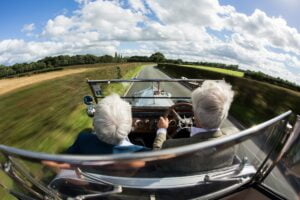Get Walking: The Ultimate Elixir for a Healthy Lifestyle

Imagine walking down a narrow cobblestone street, the air filled with the scent of fresh coffee and baking bread, as you greet your neighbours with a smile. This is a common scene in many European countries, where walking is not just a mode of transportation, but a cherished part of the cultural fabric. This picture, so simple yet captivating, is often absent in the American lifestyle, where the car reigns supreme and walking can be viewed as an unusual, even peculiar, activity. But why the stark contrast? And what can we learn from this tale of two cultures?
We are constantly bombarded with new workout trends, gym memberships, and sophisticated fitness equipment. It’s easy to overlook the simplest yet most effective form of exercise—walking. Walking, often regarded as the most perfect exercise, is accessible, affordable, and has numerous health benefits. Let’s delve into the reasons why walking is the ultimate medicine and explore how you can get started with a fun walking program and incorporate specific walking workouts into your daily routine.
Walking is not only a natural and convenient form of exercise, but it also offers a multitude of health benefits. According to the experts at Harvard Medical School, walking can help lower your risk of heart disease, cancer, and diabetes. Additionally, it can help maintain healthy blood pressure and cholesterol levels, support weight management, and even keep your memory sharp.
The key to walking’s effectiveness lies in its low-impact nature, which makes it a safe and sustainable exercise for people of all ages and fitness levels. As a weight-bearing activity, walking can also help improve bone density, thereby reducing the risk of osteoporosis. Walking can contribute to mental well-being by reducing stress, anxiety, and depression, as well as promoting a sense of relaxation and happiness.

Get walking for fun
Beginning a walking program is as simple as stepping out the door. However, before you get started, it’s essential to consider your current fitness level and set realistic goals. Consult with your healthcare provider if you have any pre-existing conditions or concerns about starting a new exercise routine.
Choose the right gear: Invest in a pair of comfortable, well-fitting walking shoes that provide good arch support and cushioning. Make sure to wear breathable and moisture-wicking clothing to keep you cool and dry.
Start slow: If you’re new to walking, start with a moderate pace for 10-15 minutes a day, gradually increasing the duration and intensity over time. Aim for at least 150 minutes of moderate-intensity or 75 minutes of vigorous-intensity aerobic activity per week, as recommended by the American Heart Association.
Warm-up and cool-down: Begin each walking session with a 5-minute warm-up of gentle stretching and slow-paced walking. Finish with a 5-minute cool-down, gradually decreasing your walking pace and concluding with stretching exercises to maintain flexibility.
Focus on proper form: Keep your head up, shoulders relaxed, and your gaze fixed on the horizon. Maintain a natural stride and engage your core muscles for stability. Swing your arms naturally and avoid over-striding, which can lead to injuries.
Track your progress: Use a pedometer, smartphone app, or a fitness tracker to monitor your steps, distance, and time. Keeping track of your progress can help you stay motivated and accountable to your goals.

Choose your walking style
As you become more comfortable with walking, you can incorporate different walking workouts to increase the challenge and variety. Here are a few ideas:
Interval walking: Alternate between periods of brisk walking and slower-paced recovery walking. For example, walk at a brisk pace for 2 minutes, followed by 2 minutes of slower-paced walking, and repeat this pattern for 20-30 minutes.
Incline walking: Find a hill or use a treadmill with an incline setting to challenge yourself with uphill walking. Begin with a moderate incline and gradually increase the incline as you become stronger.
Power walking: Increase your pace and pump your arms to transform your walk into an intense, calorie-burning workout.
Walking with weights: Add light hand or ankle weights to increase resistance and strengthen your upper and lower body muscles.

The power of walking: a cultural shift
The heart of European cities beats in rhythm with the footsteps of its citizens. Centuries-old urban design and infrastructure, built before the era of automobiles, naturally favor pedestrian movement. The streets invite exploration, and the proximity of homes, shops, and cafes make walking a practical and enjoyable endeavor. Moreover, efficient public transportation networks tie the city together, with walking as the connecting thread that leads people to and from bus stops, train stations, or metro lines.
But it’s not just about practicality. There is a certain romance in the European walking culture. It’s in the cherished traditions of the leisurely evening strolls – the Italian ‘passeggiata’ or the Spanish ‘paseo’. It’s in the slower pace of life that encourages connection – connection to one’s surroundings, to one’s community, and to oneself. Walking is more than just a means to get from point A to point B; it’s a dance of life that unfolds with each step.
Across the ocean, American cities, many born in the age of the automobile, stretch out in wide expanses. The vast distances and lack of pedestrian infrastructure can make walking a challenge, if not a hazard. In the land of efficiency and time management, walking is often seen as less practical, a quaint pastime rather than a daily necessity. Yet beneath this perception lies an untapped potential. The simple act of walking can become a pathway to a healthier, more sustainable, and more connected society.

Imagine the American lifestyle with less cars and more walking! Creating more pedestrian-friendly spaces, we can transform walking from a hazardous task into a safe and healthy experience. Investing in better sidewalks, crosswalks, and green spaces can encourage people to embrace the joy of walking.
Simultaneously, enhancing public transportation networks can shift the paradigm from car dependence to a balanced transport ecosystem. With each bus ride or metro journey, walking can become an normal part of the daily commute, opening up opportunities for exercise, reflection, and connection.
However, infrastructure changes alone are not enough. We need a cultural revolution that celebrates the virtues of walking. By promoting the health, environmental, and social benefits of walking, we can inspire individuals, schools, workplaces, and local governments to embrace this simple yet powerful activity.
Imagine if we could infuse the rhythm of the European ‘passeggiata’ into the American lifestyle. Imagine if we could slow down, step out of our vehicles, and reconnect with our surroundings and communities. Imagine if we could transform walking from a strange activity into a celebrated ritual.
This vision is not a distant dream. It’s a possibility that lies within our reach. All it takes is a shift in perspective, a step in the right direction. So, let’s lace up our walking shoes and embark on this journey. For in the words of poet Mary Oliver, “This is the world. Beautiful and terrible things will happen. Don’t be afraid. I am with you. I am your friend. And I am learning to walk.”
Walking: understanding the cultural differences around the world
In many countries around the world, walking is deeply ingrained in the culture and daily life. For instance, in European countries like Italy, Spain, and France, walking is a key aspect of their lifestyle. In contrast, walking is not as widespread in the United States, and it’s often considered unusual or even strange to walk long distances.
Urban design and infrastructure: European cities, particularly those with a rich history, often have compact urban centres with narrow, pedestrian-friendly streets. These cities were built long before the advent of cars, making walking a natural and convenient mode of transportation. On the other hand, many American cities, especially those established after the rise of the automobile, have sprawling designs with wide roads and a lack of pedestrian infrastructure. This urban layout makes it challenging and sometimes unsafe to walk.
Public transportation: European countries typically have extensive and efficient public transportation networks, which often involve walking to and from bus stops, train stations, or metro lines. In contrast, the United States has a less comprehensive public transit system, leading to a higher reliance on personal vehicles for transportation.

Cultural attitudes: Walking is deeply rooted in the European way of life, and activities such as taking a leisurely evening stroll (passeggiata in Italy or paseo in Spain) are cherished traditions. The slower pace of life in many European cities encourages people to walk and engage in social interactions. In the United States, there is a stronger emphasis on efficiency and time management, which may make walking seem less practical and even strange to some.
Health and environmental awareness: European countries generally have a higher awareness of the health and environmental benefits of walking. Many cities actively promote walking through car-free zones, pedestrianization projects, and walking events. Conversely, in the United States, walking for transportation or leisure is not as widely encouraged, and many people might not be fully aware of its benefits.





